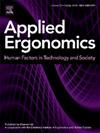Temporospatial gait analysis of squat walking using a passive lower extremity exoskeleton
IF 3.4
2区 工程技术
Q2 ENGINEERING, INDUSTRIAL
引用次数: 0
Abstract
This study examined the impact of a chair-type wearable exoskeleton (CEX) on ambulation in a squatting posture. Twenty participants underwent forward, backward, and sideways walking trials with and without the CEX. Results indicated a significant (more than 70 %) reduction in anterior and posterior walking speed on CEX, while lateral walking speed remained unaffected (less than 25 %). Despite the diminished pace in forward and backward walking, CEX demonstrated potential as a dynamic assistive device in occupations involving frequent squatting. More importantly, lateral walking with CEX did not exhibit a significant decrease in speed compared to walking without the device, positioning it as a pragmatic solution for individuals operating in lowered workplaces without compromising overall productivity. These findings highlight the potential of the CEX as an effective intervention to enhance mobility while squatting in confined areas, such as during tile installation. The study provides recommendations for safe and effective utilization of CEX in the workplace.
下肢被动外骨骼下蹲行走的时空步态分析
这项研究检查了椅子型可穿戴外骨骼(CEX)对蹲姿行走的影响。20名参与者分别在有或没有CEX的情况下进行了向前、向后和侧向行走试验。结果显示,CEX治疗组前后行走速度显著降低(超过70%),而侧行速度未受影响(小于25%)。尽管向前和向后行走的速度降低,但CEX显示出在频繁下蹲的职业中作为动态辅助装置的潜力。更重要的是,与不带CEX行走相比,带CEX横向行走的速度并没有明显下降,这使其成为一个实用的解决方案,适用于在较低的工作场所工作的个人,而不会影响整体生产力。这些研究结果强调了CEX作为一种有效干预措施的潜力,可以提高蹲在受限区域(如安装瓷砖期间)的活动能力。该研究为工作场所安全有效地使用CEX提供了建议。
本文章由计算机程序翻译,如有差异,请以英文原文为准。
求助全文
约1分钟内获得全文
求助全文
来源期刊

Applied Ergonomics
工程技术-工程:工业
CiteScore
7.50
自引率
9.40%
发文量
248
审稿时长
53 days
期刊介绍:
Applied Ergonomics is aimed at ergonomists and all those interested in applying ergonomics/human factors in the design, planning and management of technical and social systems at work or leisure. Readership is truly international with subscribers in over 50 countries. Professionals for whom Applied Ergonomics is of interest include: ergonomists, designers, industrial engineers, health and safety specialists, systems engineers, design engineers, organizational psychologists, occupational health specialists and human-computer interaction specialists.
 求助内容:
求助内容: 应助结果提醒方式:
应助结果提醒方式:


